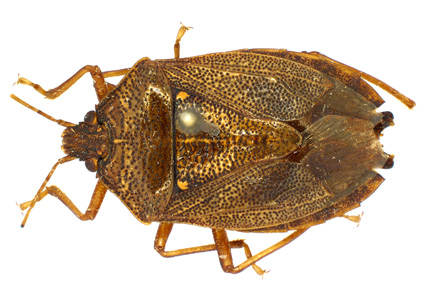Abstract
When examining specimens of the Janeirona Distant, 1911 clade of Ochlerini (Discocephalinae) we found males and females of two undescribed species. Though clearly similar to the genera in the Janeirona clade, these two species lack the diagnostic characteristics of any of them. We made a cladistic analysis to verify the placement of the two new species in Discocephalinae. A total of 38 taxa and 60 morphological characters were included in the analysis. Character polarization followed the outgroup comparison method, and the most parsimonious trees were calculated in TNT using an implied weighting approach. The analysis resulted in one most parsimonious tree where the two new species form a monophyletic group within the Ochlerini, sister to Janeirona. We propose Paropsocolis Sampaio & Campos, gen. nov. for the two new species Paropsocolis convergens Sampaio & Campos, sp. nov. and Paropsocolis divergens Sampaio & Campos, sp. nov.. The new genus is recognized by having an inconspicuous labial intercalary segment, metasternum anteriorly carinated, parameres with a basal dish-shaped process and a bifurcated apex, theca with one apical ventral process, endosoma with one dorsal and one ventral processes, laterotergites IX surpassing the mediotergite VIII, and thickening of vaginal intima circular. P. convergens Sampaio & Campos, sp. nov. and P. divergens Sampaio & Campos, sp. nov. are described to Brazil. A distributional map is provided.
References
- Bremer, K. (1994) Branch support and tree stability. Cladistics, 10 (3), 295–304. https://doi.org/10.1111/j.1096-0031.1994.tb00179.x
- Campos, L.A. & Grazia, J. (2006) Análise cladística e biogeografia de Ochlerini (Heteroptera, Pentatomidae, Discocephalinae). Iheringia, Série Zoologia, 96 (2), 147–163. https://doi.org/10.1590/S0073-47212006000200004
- Goloboff, P.A., Farris, J.S., Källersjö, M., Oxelman, B., Ramírez, M.J. & Szumik, C.A. (2003) Improvements to resampling measures of group support. Cladistics, 19 (4), 324–332. https://doi.org/10.1111/j.1096-0031.2003.tb00376.x
- Goloboff, P.A., Farris, J.S. & Nixon, K.C. (2008) TNT, a free program for phylogenetic analysis. Cladistics, 24 (5), 774–786. https://doi.org/10.1111/j.1096-0031.2008.00217.x
- Goloboff, P.A. & Morales, M. (2023) TNT version 1.6, with a graphical interface for MacOs and Linux, including new routines in parallel. Cladistics, 39 (2), 144–153.
- https://doi.org/10.1111/cla.12524
- Kment, P. & Vilímová, J. (2010) Thoracic scent efferent system of Pentatomoidea (Hemiptera: Heteroptera): A review of terminology. Zootaxa, 2706 (1), 1–77. https://doi.org/10.11646/zootaxa.2706.1.1
- Konstantinov, F.V. & Gapon, D.A. (2005) On the structure of the aedeagus of shield bugs (Heteroptera, Pentatomidae): 1. Subfamilies Discocephalinae and Phyllocephalinae. Entomological Review, 85 (3), 221–235.
- Roell, T. & Campos, L.A. (2019) Phylogeny of Ochlerini (Hemiptera: Pentatomidae: Discocephalinae) and the evolution of the apical tarsomere in hind legs. Zoological Journal of the Linnean Society, 185 (4), 1137–1149. https://doi.org/10.1093/zoolinnean/zly073
- Rosso, P. & Campos, L.A. (2021) Revision of Ischnopelta Stål, 1868 with the description of twenty new species (Hemiptera: Pentatomidae: Discocephalinae). Megataxa, 006 (2), 096–184.
- https://doi.org/10.11646/megataxa.6.2.3
- Maddison W.P. & Maddison D.R. (2021) Mesquite: a modular system for evolutionary analysis. Version 3.70. Available from http://www.mesquiteproject.org/Installation.html/ (accessed 28 March 2023)
- Nixon, K.C. & Carpenter, J.M. (1993) On Outgroups. Cladistics, 9 (4), 413–426. https://doi.org/10.1111/j.1096-0031.1993.tb00234.x
- Nixon, K.C. (2002) WinClada. Version 1.00.08. Published by the author, Ithaca. [software]
- Schuh, R.T. & Weirauch, C. (2020) True bugs of the world (Hemiptera: Heteroptera): classification and natural history. Siri Scientific Press, Rochdale, 800 pp.
- Weiler, L., Ferrari, A. & Grazia, J. (2016) Phylogeny and biogeography of the South American subgenus Euschistus (Lycipta) Stål (Heteroptera: Pentatomidae: Carpocorini). Insect Systematics & Evolution, 47 (4), 313–346. https://doi.org/10.1163/1876312X-47032145
- Zhou, Y. & Rédei, D. (2020) From lanceolate to plate-like: Gross morphology, terminology, and evolutionary trends of the trichophoran ovipositor. Arthropod Structure & Development, 54, 100914. https://doi.org/10.1016/j.asd.2020.100914


